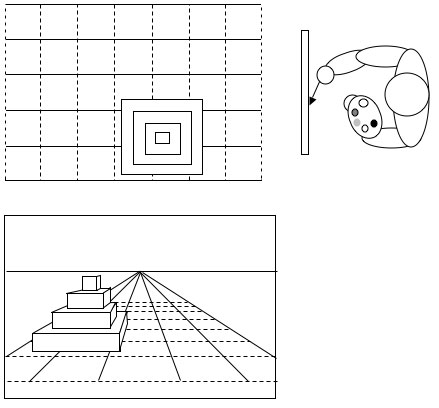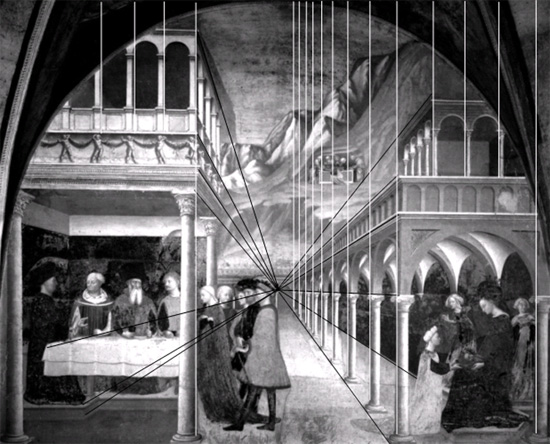The Role of Perspective in Shaping the Renaissance
2. The projections of all lines that are parallel in
space either remain parallel in the picture plane or intersect at a single
vanishing point (Fig. 1). Although the lines run to infinity in space,
their projection to a picture plane has a vanishing point at a specific
location. Each different set of parallel lines intersects at a different
vanishing point. Thus, the first job in perspective projection is to identify
all the lines in the scene that are parallel to each other, then make
sure that they are drawn so as to project to a common vanishing point.
 |
|
Fig. 3A. A painter at his canvas painting a scene of a rectangular grid with ziggurat. Dashed lines in the grid are parallel to the canvas (transversals), solid lines are perpendicular to it. B. Depiction of the scene as projecting to the plane of the canvas, with the perpendicular lines converging at the central vanishing point, while the transversals remain parallel to it.
|
 |
Central perspective is illustrated by the earliest exponent of accurate perspective, Masolino da Panicale, in his ‘Herod’s Feast’ (Fig. 4). The primary set of parallels is those horizontal and receding from a viewer toward the central vanishing point. The other sets of parallels consist of any lines at right angles to the first set, at any angle within the picture plane. These parallels, such as the verticals of the sides of buildings, will all remain parallel within the picture plane.
 |
| Fig. 4. Early example of central
perspective. ‘Herod’s Feast’ by Masolino (1435),
where many receding horizontal lines project to a single central
vanishing point (red lines). This is one-point perspective because
the horizontal (black) and vertical (white) sets of parallel lines
project as parallel in the picture. |
 |
A particular case of the lack of distortion in central projection is the case of circles, and circular arches (such as those at right in Fig. 4). When they are facing us, i.e., parallel to the picture plane, circles and parts of circles remain circular in the projection to the picture. The projection to the retina distorts them to ellipses, but they should be shown as circular in the picture.
